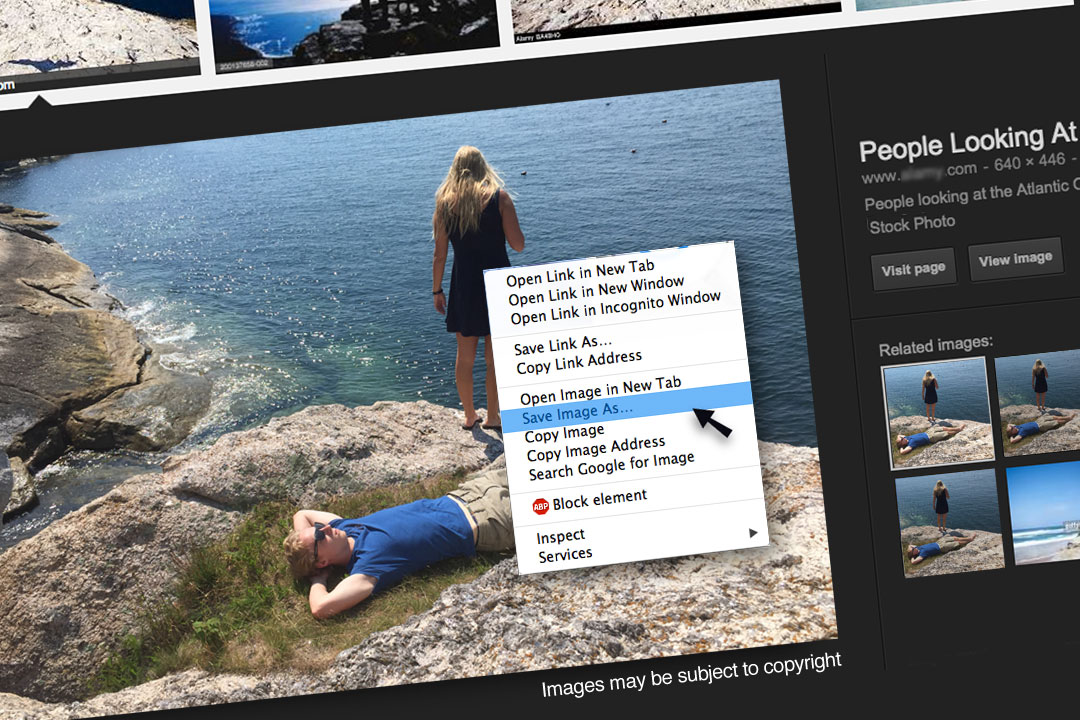Grabbing photos off Google Images can get you sued
By Judy In Branding, Marketing, Website DesignSo you’re looking for a picture for your brochure, website or blog, and looking through Google Images you find a great one. So you download it and plop it in place. Hey, if it’s on the internet it’s free, right?
WRONG. Just because an image is on the internet doesn’t mean it’s free to use. Learning the basics of copyright infringement law now can save you a very expensive lesson later.
There is a very common – and potentially very expensive – misconception that if an image is on the web, it’s in the public domain, and up for grabs. There is a big difference between an image being online and an image being “in the public domain” (the term given to content that is not owned or controlled by anyone). According to the Berne Convention (adopted by 160 countries) and the U.S. Copyright Act of 1976, copyright protection is provided automatically by law to the creator of any original work from the time of its creation until 70 years after the death of the creator. Only after that time, and if other protections have not been put in place, does an image fall into the public domain.
Additionally, the Digital Millennium Copyright Act further enhances the protections for creators against copyright infringement on the internet.
Another fun fact is that the creator of artwork retains the copyright to the art even if they’ve been contracted to create it. That means that if you hire an artist or photographer to create work for your company, the artist retains the copyright, even if you pay for the product, unless there is a copyright transfer agreement. You cannot sell it or use it for another company or other use without permission from the copyright owner.
What exactly is copyright infringement?Using copyrighted material you don’t have express written permission to use is copyright infringement, and can cost you much more than the price of a stock photo. It can leave you liable to be sued, often for many thousands of dollars.
Using copyrighted art without permission limits your options too. You can’t use copyrighted artwork in a logo or other art and then copyright it yourself! If you want to copyright or trademark a logo, it’s essential to only use legal or original art.
They’ll never catch me anyway. The internet’s a big place, right?Wrong. Technology enables copyright owners to identify unlicensed images.
Images can be digitally “fingerprinted”, so that they can be tracked and found, even if they’ve been modified or re-created. With all the blogging going on and websites being created today, copyright protection technology has made great advancements and infringement lawsuits are a big business.
Oops! What if I just apologize and take it down?Unfortunately, the law isn’t very understanding of mistakes, and there’s a whole industry of lawyers out there that make their living off this issue, and they’re not swayed by the argument that you didn’t understand the law, or are sorry.
According to fair use copyright law, you are financially liable for using copyrighted images even if it’s by accident, or you cite the creator, or link back to the source, or even if you’re not using it for commercial purposes. Another common misconception is that a copyright offender won’t be sued if they take down or remove an illegal image upon request. You are liable from the moment of infringement.
The bottom line is, to stay legal and keep yourself safe from eager copyright lawyers, you must have express written permission from the copyright owner to use an image.
So what are you supposed to do?Only use artwork you have written permission to use.
If you see a photo or graphic on Google Images or elsewhere that isn’t from a stock house, contact the webmaster or artist and ask permission to use it. Far more often than not the owner of the art is willing to give permission or negotiate use.
Get your images from stock sites.
Stock image sites – both free and paid – are one of the best ways to get good-quality images with permission. When you use a stock image, you’re getting a license agreement that allows you to legally use the image under certain rules. However, be sure to read and understand the fine print.
Your license agreement will tell you exactly how you’re permitted to use the image. Often a license agreement will allow some uses (editorial, web-only, etc. ) but not others. You may be required to credit the artist or buy an enhanced license for certain uses. Even free images or graphics can have some restrictions on their use. They may require a credit or link, or may restrict modifications.
And be aware – royalty free is not copyright free.
Nor does it mean free of charge. Many stock sites sell usage of royalty free images. Royalty free means that you pay a flat fee and are free to use the image as many times as you want without extra charge. The creator still retains the copyright, and you are limited to the uses in your license agreement.
Use public domain or waived rights images
There are many websites that have collections of images that are in the public domain, including Morguefile.com. With public domain images you’re free to use them in any way and in most cases you don’t have to provide attribution. However, always check the terms of the site. Creative Commons is a non-profit organization that offers many images with waived rights. Again, read the license agreement carefully, as there are levels of restrictions.
With a little knowledge and attention you can keep your website, blog or marketing materials full of engaging and legal images, and keep yourself out of court.

